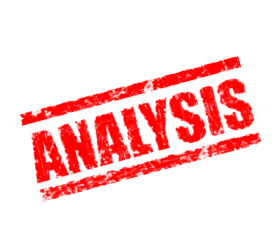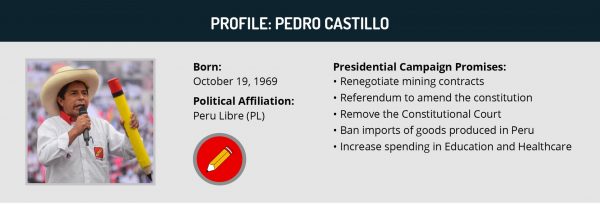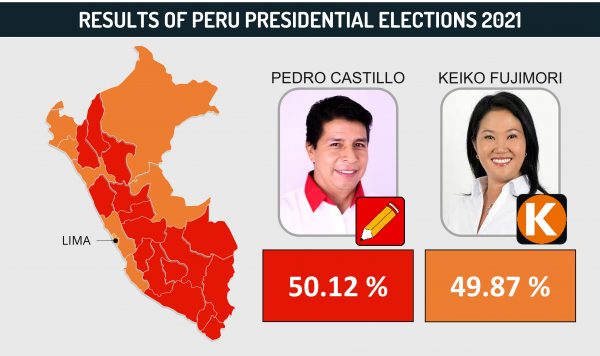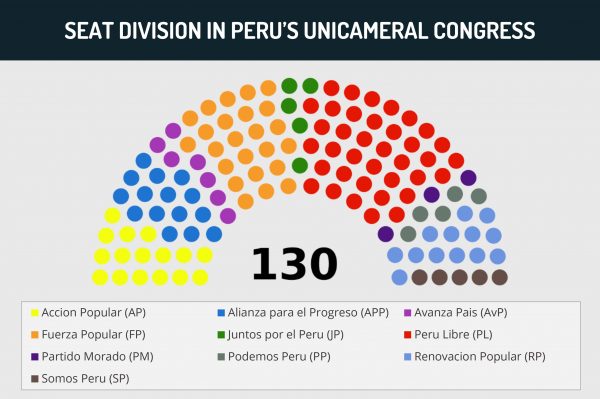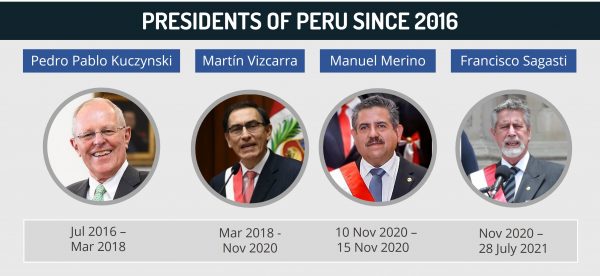Peru Analysis: Pedro Castillo’s presidential term to be marked by constant standoff with Congress over populist reforms
Executive Summary
- Left-wing Pedro Castillo won the second round of presidential elections in Peru held on June 6 with a slight margin over right-wing Keiko Fujimori after a lengthy confirmation process.
- Widespread support from rural voters for proposed radical reforms amid the ongoing economic crisis helped Castillo win the elections with a slight margin,
- Castillo’s presidential term to witness constant standoff with Congress with the President facing the constant threat of impeachment due to lack of support.
- Congress blocking Castillo’s measures are likely to trigger large-scale protests, with the ensuing social unrest to impede Peru’s post-COVID-19 pandemic recovery.
- Travel to Peru may continue as per government directives concerning the ongoing COVID-19 restrictions while maintaining heightened vigilance for ongoing unrest.
Current Situation
- On June 6, Peru held the second round of Presidential elections in a highly polarized contest between Peru Libre’s left-wing candidate Pedro Castillo and Fuerza Popular’s right-wing candidate Keiko Fujimori.
- Castillo won the elections with a slight margin of 50.1 percent of votes, compared to Fujimori who secured the support of 49.8 percent of votes after the Oficina Nacional de Procesos Electorales (ONPE), Peru’s election body, completed the initial vote count. However, the official declaration was delayed until July 19 due to vote requests submitted by both parties, primarily Fujimori who contested around 200,000 votes.
- On May 23, 16 people, including two minors, were shot dead in the village of San Miguel del Ene in Satipo, located in the Valle de los Rios Apurimac, Ene y Mantaro (VRAEM) mountainous region. The attack was attributed to a dissident faction of the left-wing Sendero Luminoso (Shining Path) militant rebel group, which was engaged in a violent conflict with the state during the 1980-90s.
- Fujimori, who advocated a tough line on security during her campaign associated Castillo and his party with the militant group. Castillo, during his term as the leader of the education workers’ union SUTEP, was accused of having ties with Movimiento por la Amnistía y los Derechos Fundamentales (Movadef), the alleged political wing of Shining Path. However, Castillo denounced the May 23 attack stating similar massacres had occurred in the run-up to the 2011 and 2016 presidential elections, in which Fujimori contested.
Background
- Peru is one of the worst-affected Latin American countries due to the COVID-19 pandemic, registering over 2 million cases. The outbreak caused a tremendous strain on the underinvested healthcare system, highlighted by a lack of medical oxygen, ICU beds, and substandard testing capabilities. On May 31, Peru nearly tripled its death toll due to the COVID-19 outbreak, becoming the country with the highest mortality rate per capita at over 500 per 100,000 people out of a population of 32.6 million. A total of 195,243 deaths have been recorded as of July 20, with only 12.27 percent of the population fully vaccinated.
- Peru has witnessed four Presidents in five years, with three of them being appointed in 2020. No political party holds a clear majority in the 130-seat Congress, with achieving a working collaboration over key issues remaining one of the biggest challenges. Peru Libre party has the largest representation with 37 seats, followed by Keiko Fujimori’s Fuerza Popular with 24 seats.
Assessments & Forecasts
Mobilizing anti-establishment votes, support from rural areas for radical economic changes helped Castillo gain narrow margin over Fujimori
- Given that Pedro Castillo is the first Peruvian indigenous left-wing President to be elected from the rural portions of the country, the results highlight a major shift in national politics with regional movements steering the electoral mandate to successfully elect a left-wing president. This in turn reinforces the resurgence of left-wing politics in Latin America, supported by recent political developments in Chile and Colombia.
- Prevailing uncertainty due to acute social and economic crisis likely emboldened the rural voters, who were disproportionately affected by the economic slowdown, to support Castillo’s platform promoting far-left radical economic reforms. This is supported by Castillo emerging with over two-thirds of the vote in several rural departments of the country, compared to the electoral base in Lima which extensively supported Fujimori.
- General dissatisfaction against lawmakers over several corruption allegations, particularly with rival candidate Keiko Fujimori being charged in a multi-million fraud case, in addition to her party blocking the functioning of Congress in recent years, found enhanced support for Castillo’s anti-corruption guarantees and overall anti-establishment platform. A referendum to draft a new constitution, dissolving the constitutional court, and replacing parts of the judicial system with popularly elected judges were promoted as Castillo’s immediate measures to counter systemic corruption.
- Mobilizing anti-establishment votes to a large extent, in addition to a lot of spoiled and blank votes cast by people who did not support Fujimori’s authoritarian leanings, given her father and former President Alberto Fujimori’s autocratic administration which was accused of corruption and human rights abuses, helped Castillo gain the narrow edge. This was accomplished by Castillo promoting a pacified version of his more radical stand on economic policies and his efforts to distance himself from the hard-left factions of his own party. His twelve-page government plan distancing himself from Peru Libre’s Ideario y Programa platform highlighted his efforts to win the support of those outside the far-left and to counter the fears of a failed communist state disseminated by the right-wing opponent.
- Additionally, Castillo rebuked his alleged links to left-wing militant group Shining Path by touting his allegiance to the Rondero group which stood guard during the Maoist insurgency in Peru, thus promising a tough stance on security issues.
Castillo’s populist economic policies to render instability among the business class
- Pedro Castillo’s victory is likely to provoke immediate ramifications for the local mining industry, despite his backtracking from his initial claims to nationalize natural resources to retain much of the profits within the country. Regardless, subsequent proposals to renegotiate contracts with mining firms and to tax windfall profits by potentially shelving tax stability agreements transpires as a challenge to the operations of mining businesses.
- That said, the government is likely to engage in talks with key stakeholders in the mining industry within the first hundred days of Castillo’s presidency, as indicated in his government plan. In the medium term, the president is more likely to use his executive powers to attempt to increase regulations within the industry, with the Congress standing as a roadblock to implementing many of his proposals. Decisions may also include withholding or not renewing mining permits under non-compliance.
- Castillo’s promises to prohibit imports of goods produced in the country and allocate up to 20 percent of the GDP to enhance the healthcare sector and education seem is unlikely to yield any tangible results in the near-to-medium term and were likely promoted with the aim to win popular support. FORECAST: Regardless, the President is likely to raise import tariffs and push for tax hikes on multinational businesses in a bid to support local producers in the near-to-medium term.
- FORECAST: Limited support from Congress is likely to further moderate Castillo’s proposed economic reforms, with right-wing parties spearheaded by Fujimori’s Fuerza Popular, expected to prevent any anti-business and hurting open market sentiments from the President. As such, Castillo is likely to reach out to the business class to instill confidence in his administration. Measures are also likely to include the appointment of lawmakers who have good ties with the business class in Castillo’s government.
Instability to persist as constant standoff with Congress to mark Castillo’s presidential term
- A weak electoral mandate comprising mostly of the rural voter base, the absence of a legislative majority, and Castillo’s lack of experience are likely to limit his ability to navigate Peru’s already unruly politics. Given that the country has seen four Presidents since the 2016 general elections, with Congress ousting two of his successors in recent years, Castillo faces the continued threat of impeachment during his term.
- Indeed, Castillo’s reformist agenda, including the proposed referendum to amend the 1993 constitution is unlikely to get through Congress, with major right-wing factions uniting against the President in the near term, exacerbating the tensions between Congress and Castillo.
- FORECAST: In order to proceed with his legislative agenda, the President is expected to reach out to other left-wing parties in Congress, with an immediate ally likely to be the left-wing Juntos por el Peru (JPP) coalition. Given Castillo’s efforts to distance himself from Peru Libre’s (PL) radical platform, it is likely to put him at odds with party leader Vladimir Cerron. As such, the President stands to lose support from PL, however, Castillo is expected to push towards maintaining a balance in order to ensure support.
- FORECAST: From this balancing of interests, policy stagnation is likely to ensue with constant standoffs between the legislature and executive. Further, judging by Castillo’s leftist allegiance, the President is likely to attempt to implement authoritarian measures, possibly even dissolving Congress, to consolidate power. Proposed populist reforms are expected to rake in further support for Castillo and his party from the general population, exacerbating the detest against lawmakers.
- FORECAST: Meanwhile, Congress is likely to table legislation aimed at limiting the powers of the President. This is evidenced by the recent proposal to amend the ‘Cuestion de Confianza’ which allows the President to dissolve Congress if it issues two votes of no confidence on a “bill of national importance.” As such, the aforementioned obstacles are likely to hinder the chances of Pedro Castillo making it to the next Presidential elections in 2026. Judging by his left-wing leanings, Castillo may also attempt to introduce constitutional amendments to allow an incumbent president to re-run for office if he stays in power until 2026. However, such a move is unlikely to be passed by Congress if parties supporting Castillo fail to achieve a majority in the next general elections.
Castillo-Congress standoff to trigger mass protests, drug trafficking operations by Shining Path to increase
- Congress hindering the passage of Castillo’s proposed reforms is likely to trigger mass protests, with the President expected to call on his support base to mobilize against the legislature as witnessed during the anti-government protests of 2019-20. The social unrest will further hurt investor sentiments and business continuity, impeding Peru’s path to economic recovery following the COVID-19 pandemic.
- Protests led by right-wing parties and Castillo opponents are also expected to intensify as the President attempts to progress his agenda. These protests are likely to be extensively supported by the media and business class, judging by their sustained support for Fujimori during the Presidential elections. This is especially true in major cities, including Lima, where opposition is strongest.
- FORECAST: The perception of a left-wing President is likely to embolden the operations of the dissidents of the Shining Path militant group, which largely facilitates cocaine production and illegal drug trade majorly concentrated in the Valle de los Ríos Apurímac, Ene y Mantaro (VRAEM) region. The drug traffickers are likely to interpret Castillo’s left-wing background as favorable for them, despite the President denouncing the militant group. As such, clashes between armed forces and guerrillas are likely to intensify in the region. Locals and indigenous people supporting security forces in their operations against Shining Path may lead to similar massacres as observed on May 23.
- FORECAST: Given that Castillo’s government plan indicated increasing quotas for the country’s legal coca production in an effort to stem illegal cultivation of the plant for drug trafficking, there remains a possibility of an increase in the illegal trade of the drug, with legally produced quotas seeping into illegal trafficking as organized criminal groups strengthen their operations in the near-to-medium term.
- FORECAST: Castillo’s administration is expected to continue and reinforce the clampdown on illegal mining in wildlife reserves and indigenous areas. Operations are likely to be focused around the Pariamanu river in the Madre de Dios region of the Peruvian Amazon, where several illegal gold mines were destroyed in recent years.
Recommendations
- Travel to Peru may continue as per government directives concerning the ongoing COVID-19 restrictions.
- Those operating or residing in Peru are advised to remain cognizant of the ongoing political developments and the latent risk of civil unrest in the coming months.
- Maintain heightened vigilance in the vicinity of public gatherings due to the potential for unrest.
- Those operating in the VRAEM region are advised to minimize travel in areas close to the border.
- For more information on the security situation, please contact intel@max-security.com.
Executive Summary
- Left-wing Pedro Castillo won the second round of presidential elections in Peru held on June 6 with a slight margin over right-wing Keiko Fujimori after a lengthy confirmation process.
- Widespread support from rural voters for proposed radical reforms amid the ongoing economic crisis helped Castillo win the elections with a slight margin,
- Castillo’s presidential term to witness constant standoff with Congress with the President facing the constant threat of impeachment due to lack of support.
- Congress blocking Castillo’s measures are likely to trigger large-scale protests, with the ensuing social unrest to impede Peru’s post-COVID-19 pandemic recovery.
- Travel to Peru may continue as per government directives concerning the ongoing COVID-19 restrictions while maintaining heightened vigilance for ongoing unrest.
Current Situation
- On June 6, Peru held the second round of Presidential elections in a highly polarized contest between Peru Libre’s left-wing candidate Pedro Castillo and Fuerza Popular’s right-wing candidate Keiko Fujimori.
- Castillo won the elections with a slight margin of 50.1 percent of votes, compared to Fujimori who secured the support of 49.8 percent of votes after the Oficina Nacional de Procesos Electorales (ONPE), Peru’s election body, completed the initial vote count. However, the official declaration was delayed until July 19 due to vote requests submitted by both parties, primarily Fujimori who contested around 200,000 votes.
- On May 23, 16 people, including two minors, were shot dead in the village of San Miguel del Ene in Satipo, located in the Valle de los Rios Apurimac, Ene y Mantaro (VRAEM) mountainous region. The attack was attributed to a dissident faction of the left-wing Sendero Luminoso (Shining Path) militant rebel group, which was engaged in a violent conflict with the state during the 1980-90s.
- Fujimori, who advocated a tough line on security during her campaign associated Castillo and his party with the militant group. Castillo, during his term as the leader of the education workers’ union SUTEP, was accused of having ties with Movimiento por la Amnistía y los Derechos Fundamentales (Movadef), the alleged political wing of Shining Path. However, Castillo denounced the May 23 attack stating similar massacres had occurred in the run-up to the 2011 and 2016 presidential elections, in which Fujimori contested.
Background
- Peru is one of the worst-affected Latin American countries due to the COVID-19 pandemic, registering over 2 million cases. The outbreak caused a tremendous strain on the underinvested healthcare system, highlighted by a lack of medical oxygen, ICU beds, and substandard testing capabilities. On May 31, Peru nearly tripled its death toll due to the COVID-19 outbreak, becoming the country with the highest mortality rate per capita at over 500 per 100,000 people out of a population of 32.6 million. A total of 195,243 deaths have been recorded as of July 20, with only 12.27 percent of the population fully vaccinated.
- Peru has witnessed four Presidents in five years, with three of them being appointed in 2020. No political party holds a clear majority in the 130-seat Congress, with achieving a working collaboration over key issues remaining one of the biggest challenges. Peru Libre party has the largest representation with 37 seats, followed by Keiko Fujimori’s Fuerza Popular with 24 seats.
Assessments & Forecasts
Mobilizing anti-establishment votes, support from rural areas for radical economic changes helped Castillo gain narrow margin over Fujimori
- Given that Pedro Castillo is the first Peruvian indigenous left-wing President to be elected from the rural portions of the country, the results highlight a major shift in national politics with regional movements steering the electoral mandate to successfully elect a left-wing president. This in turn reinforces the resurgence of left-wing politics in Latin America, supported by recent political developments in Chile and Colombia.
- Prevailing uncertainty due to acute social and economic crisis likely emboldened the rural voters, who were disproportionately affected by the economic slowdown, to support Castillo’s platform promoting far-left radical economic reforms. This is supported by Castillo emerging with over two-thirds of the vote in several rural departments of the country, compared to the electoral base in Lima which extensively supported Fujimori.
- General dissatisfaction against lawmakers over several corruption allegations, particularly with rival candidate Keiko Fujimori being charged in a multi-million fraud case, in addition to her party blocking the functioning of Congress in recent years, found enhanced support for Castillo’s anti-corruption guarantees and overall anti-establishment platform. A referendum to draft a new constitution, dissolving the constitutional court, and replacing parts of the judicial system with popularly elected judges were promoted as Castillo’s immediate measures to counter systemic corruption.
- Mobilizing anti-establishment votes to a large extent, in addition to a lot of spoiled and blank votes cast by people who did not support Fujimori’s authoritarian leanings, given her father and former President Alberto Fujimori’s autocratic administration which was accused of corruption and human rights abuses, helped Castillo gain the narrow edge. This was accomplished by Castillo promoting a pacified version of his more radical stand on economic policies and his efforts to distance himself from the hard-left factions of his own party. His twelve-page government plan distancing himself from Peru Libre’s Ideario y Programa platform highlighted his efforts to win the support of those outside the far-left and to counter the fears of a failed communist state disseminated by the right-wing opponent.
- Additionally, Castillo rebuked his alleged links to left-wing militant group Shining Path by touting his allegiance to the Rondero group which stood guard during the Maoist insurgency in Peru, thus promising a tough stance on security issues.
Castillo’s populist economic policies to render instability among the business class
- Pedro Castillo’s victory is likely to provoke immediate ramifications for the local mining industry, despite his backtracking from his initial claims to nationalize natural resources to retain much of the profits within the country. Regardless, subsequent proposals to renegotiate contracts with mining firms and to tax windfall profits by potentially shelving tax stability agreements transpires as a challenge to the operations of mining businesses.
- That said, the government is likely to engage in talks with key stakeholders in the mining industry within the first hundred days of Castillo’s presidency, as indicated in his government plan. In the medium term, the president is more likely to use his executive powers to attempt to increase regulations within the industry, with the Congress standing as a roadblock to implementing many of his proposals. Decisions may also include withholding or not renewing mining permits under non-compliance.
- Castillo’s promises to prohibit imports of goods produced in the country and allocate up to 20 percent of the GDP to enhance the healthcare sector and education seem is unlikely to yield any tangible results in the near-to-medium term and were likely promoted with the aim to win popular support. FORECAST: Regardless, the President is likely to raise import tariffs and push for tax hikes on multinational businesses in a bid to support local producers in the near-to-medium term.
- FORECAST: Limited support from Congress is likely to further moderate Castillo’s proposed economic reforms, with right-wing parties spearheaded by Fujimori’s Fuerza Popular, expected to prevent any anti-business and hurting open market sentiments from the President. As such, Castillo is likely to reach out to the business class to instill confidence in his administration. Measures are also likely to include the appointment of lawmakers who have good ties with the business class in Castillo’s government.
Instability to persist as constant standoff with Congress to mark Castillo’s presidential term
- A weak electoral mandate comprising mostly of the rural voter base, the absence of a legislative majority, and Castillo’s lack of experience are likely to limit his ability to navigate Peru’s already unruly politics. Given that the country has seen four Presidents since the 2016 general elections, with Congress ousting two of his successors in recent years, Castillo faces the continued threat of impeachment during his term.
- Indeed, Castillo’s reformist agenda, including the proposed referendum to amend the 1993 constitution is unlikely to get through Congress, with major right-wing factions uniting against the President in the near term, exacerbating the tensions between Congress and Castillo.
- FORECAST: In order to proceed with his legislative agenda, the President is expected to reach out to other left-wing parties in Congress, with an immediate ally likely to be the left-wing Juntos por el Peru (JPP) coalition. Given Castillo’s efforts to distance himself from Peru Libre’s (PL) radical platform, it is likely to put him at odds with party leader Vladimir Cerron. As such, the President stands to lose support from PL, however, Castillo is expected to push towards maintaining a balance in order to ensure support.
- FORECAST: From this balancing of interests, policy stagnation is likely to ensue with constant standoffs between the legislature and executive. Further, judging by Castillo’s leftist allegiance, the President is likely to attempt to implement authoritarian measures, possibly even dissolving Congress, to consolidate power. Proposed populist reforms are expected to rake in further support for Castillo and his party from the general population, exacerbating the detest against lawmakers.
- FORECAST: Meanwhile, Congress is likely to table legislation aimed at limiting the powers of the President. This is evidenced by the recent proposal to amend the ‘Cuestion de Confianza’ which allows the President to dissolve Congress if it issues two votes of no confidence on a “bill of national importance.” As such, the aforementioned obstacles are likely to hinder the chances of Pedro Castillo making it to the next Presidential elections in 2026. Judging by his left-wing leanings, Castillo may also attempt to introduce constitutional amendments to allow an incumbent president to re-run for office if he stays in power until 2026. However, such a move is unlikely to be passed by Congress if parties supporting Castillo fail to achieve a majority in the next general elections.
Castillo-Congress standoff to trigger mass protests, drug trafficking operations by Shining Path to increase
- Congress hindering the passage of Castillo’s proposed reforms is likely to trigger mass protests, with the President expected to call on his support base to mobilize against the legislature as witnessed during the anti-government protests of 2019-20. The social unrest will further hurt investor sentiments and business continuity, impeding Peru’s path to economic recovery following the COVID-19 pandemic.
- Protests led by right-wing parties and Castillo opponents are also expected to intensify as the President attempts to progress his agenda. These protests are likely to be extensively supported by the media and business class, judging by their sustained support for Fujimori during the Presidential elections. This is especially true in major cities, including Lima, where opposition is strongest.
- FORECAST: The perception of a left-wing President is likely to embolden the operations of the dissidents of the Shining Path militant group, which largely facilitates cocaine production and illegal drug trade majorly concentrated in the Valle de los Ríos Apurímac, Ene y Mantaro (VRAEM) region. The drug traffickers are likely to interpret Castillo’s left-wing background as favorable for them, despite the President denouncing the militant group. As such, clashes between armed forces and guerrillas are likely to intensify in the region. Locals and indigenous people supporting security forces in their operations against Shining Path may lead to similar massacres as observed on May 23.
- FORECAST: Given that Castillo’s government plan indicated increasing quotas for the country’s legal coca production in an effort to stem illegal cultivation of the plant for drug trafficking, there remains a possibility of an increase in the illegal trade of the drug, with legally produced quotas seeping into illegal trafficking as organized criminal groups strengthen their operations in the near-to-medium term.
- FORECAST: Castillo’s administration is expected to continue and reinforce the clampdown on illegal mining in wildlife reserves and indigenous areas. Operations are likely to be focused around the Pariamanu river in the Madre de Dios region of the Peruvian Amazon, where several illegal gold mines were destroyed in recent years.
Recommendations
- Travel to Peru may continue as per government directives concerning the ongoing COVID-19 restrictions.
- Those operating or residing in Peru are advised to remain cognizant of the ongoing political developments and the latent risk of civil unrest in the coming months.
- Maintain heightened vigilance in the vicinity of public gatherings due to the potential for unrest.
- Those operating in the VRAEM region are advised to minimize travel in areas close to the border.
- For more information on the security situation, please contact intel@max-security.com.

